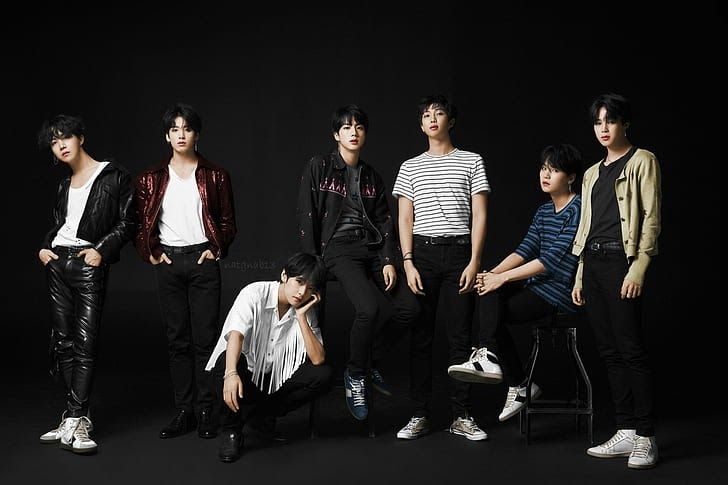BTS, or Bangtan Sonyeondan (meaning Bulletproof Boy Scouts), has risen to become a global phenomenon. Their success transcends catchy music and synchronized dance routines; it lies in their meticulous artistry, a captivating blend of powerful lyrics, intricate choreography, and stunning visuals. This essay explores the individual elements that contribute to BTS’s artistic mastery, delving into their lyricism, choreography, and the visual storytelling woven into their music videos.
Lyrics: Stories Told Through Song
BTS’s music goes beyond catchy melodies. Their lyrics, primarily in Korean, resonate deeply with audiences worldwide thanks to their relatable themes and raw authenticity. Members like RM, Suga, and J-Hope actively participate in songwriting, infusing the music with personal narratives and social commentary.
Early Struggles and Youthful Rebellion: Tracks like “No More Dream” and “N.O” from their debut albums addressed societal pressures faced by youth, striking a chord with a generation yearning for freedom of expression. Lines like “We are the generation that doesn’t know the answer, but let’s try to find it together” (“No More Dream”) connected with young listeners grappling with their place in the world.
Evolution and Self-Discovery: As BTS matured, their lyrics evolved. Albums like “Wings” and “Love Yourself 承 ‘Her’” showcased introspection and self-discovery. “Blood Sweat & Tears” explored themes of temptation and inner turmoil, while “Spring Day” tackled feelings of loss and longing. Their lyrics often delve into mental health and self-acceptance, creating a safe space for listeners to confront their own struggles.
Social Advocacy and Global Issues: BTS doesn’t shy away from social commentary. Tracks like “Intro: Persona” explore the struggles of fame and self-doubt, while “Move” celebrates individuality and embracing one’s true self. Their willingness to address crucial issues resonates with a global audience.
Breaking Language Barriers: Despite primarily singing in Korean, BTS’s music transcends language barriers. The raw emotions they express, relatable themes of love, self-discovery, and resilience, and the power of their delivery connect with audiences on a visceral level. Additionally, their use of metaphors, symbolism, and wordplay adds another layer of depth, even for those unfamiliar with the Korean language.
Choreography: A Story Told Through Movement
BTS’s choreography is not just a series of synchronized dance moves; it’s a compelling visual extension of their music. Their intricate dance routines, created by a talented team of choreographers, showcase their incredible skill, precision, and synchronized energy.
Precision and Power: BTS’s complex choreography incorporates sharp movements, synchronized formations, and powerful transitions. Tracks like “Fire” and “Black Swan” showcase their technical prowess and dynamic storytelling through dance. These demanding routines push the boundaries of performance, demanding athleticism and flawless execution.
Emotional Storytelling: Beyond technical brilliance, BTS’s choreography often reflects the emotional core of their songs. In “Spring Day,” the choreography portrays a sense of longing and searching, while “Fake Love” utilizes sharp movements to convey frustration and deception. This ability to translate emotions through dance draws viewers deeper into the song’s meaning.
Group Cohesion and Individuality: A remarkable aspect of BTS’s choreography is their ability to showcase both group cohesion and individual talent. Complex formations highlight their unity, while individual moments allow each member to shine with their unique dance styles. This balance between synchronicity and individuality is a hallmark of their artistry.
Visuals: A World of Immersive Storytelling
BTS’s music videos are more than just visuals accompanying their songs; they are meticulously crafted pieces of storytelling. In collaboration with talented directors, they create captivating narratives that often weave together across multiple videos.
Symbolism and Metaphors: BTS’s music videos are rich in symbolism. Colors, imagery, and recurring motifs are employed to create deeper meaning. In “Blood Sweat & Tears,” the use of flowers and birds symbolizes temptation and loss of innocence.
Storytelling and Cinematic Elements: Many BTS music videos are miniature films. The “Wings” era consisted of a series of videos exploring themes of ambition, temptation, and self-discovery. They utilize dramatic lighting, camera angles, and intricate sets to create an immersive experience for viewers.
Connecting with the Music: The visuals in BTS’s music videos aren’t just visually stunning; they enhance the impact of the music. The video for “Dynamite” perfectly complements the song’s vibrant energy, while the melancholic visuals of “Spring Day” create a sense of longing that resonates with the song’s themes.
The Synergy of Artistry
BTS’s brilliance lies in the synergy of their artistic elements.
